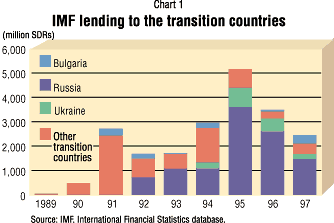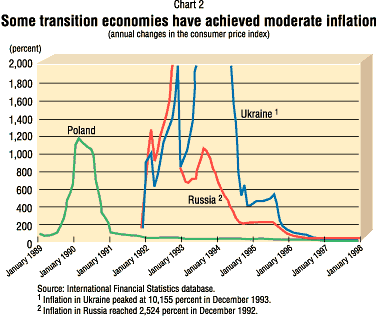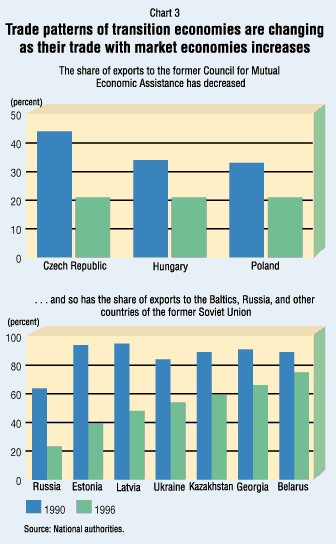 About F&D Subscribe Back Issues Write Us Copyright Information Use the free Adobe Acrobat Reader to view a pdf file of this article
|
Ten Years of Transition: A Progress Report Patrick Lenain It has been nearly ten years since the countries of Central and Eastern Europe and the former Soviet Union began the transition to a market economy. The radical changes required have made the process difficult and, at times, painful. Progress has been remarkable in a number of countries. But in others, successful market economies have not yet emerged. SOON after the fall of the Berlin Wall in 1989, the countries of Central and Eastern Europe decided to end their isolation from the international community. They applied for membership in the IMF, the World Bank, and other multilateral organizations (Hungary, Poland, and Romania had joined the IMF several years earlier). The international organizations sent missions to the countries requesting membership to assess their economic situation and determine what their initial quotas should be. The various missions found major structural handicaps and weaknesses in the countries—the legacy of central planning and ill-fated reform attempts. These countries needed not only to stabilize their economies but also to create the institutions necessary to the operation of a market system. Shortly thereafter, at the Houston summit in July 1990, the heads of state of the Group of Seven countries called upon the IMF, the World Bank, the Organization for Economic Cooperation and Development (OECD), and the designated president of the European Bank for Reconstruction and Development (EBRD) to cooperate on an economic analysis of the Soviet Union, whose economy was rapidly deteriorating. A Study of the Soviet Economy, published in 1991, found that financial, budgetary, and monetary conditions were alarming—especially the high level of external indebtedness. The subsequent dissolution of the Soviet Union brought additional economic imbalances to light. Under the circumstances, nearly all 25 post-communist countries, far-reaching adjustment and structural reform programs were put in place. It soon became evident, however, that transforming planned economies into market ones while eliminating macroeconomic imbalances would be a formidable task. No attempt at such radical and rapid reform had ever been made before, so there was no previous experience to draw on. What has been accomplished in the nearly ten years since reforms began? How successful have these countries been in eliminating external imbalances, restoring monetary stability, and achieving integration into the global trade system? (For a discussion of structural reforms and economic growth, see "The Post-Communism Transition: Patterns and Prospects" by Julian Exeter and Steven Fries in this issue). Reducing external imbalances When they started their transition to a market economy, many post-communist economies had external imbalances in the form of heavy debt-service schedules (Bulgaria and Russia), depleted foreign exchange reserves (most former Soviet Union countries), or external payment arrears (Ukraine). These difficulties had been aggravated by the breakup of traditional trade linkages following the dissolution of the Council for Mutual Economic Assistance (CMEA). One of the functions of the IMF in the context of transition was to provide financial resources to make the process of external adjustment more orderly. The credits provided by the IMF, which amounted to about $27 billion during 1989�97 (Chart 1), were used to replenish international reserves, avoid the recurrence of external arrears, and ease debt-servicing difficulties. The first "wave" of IMF credits was released in 1991 to support programs in Eastern and Central Europe (in particular, in the former Czechoslovakia, Hungary, and Romania). The second wave of credits went to the Baltics, Russia, and the other former Soviet Union countries, mainly in 1994�95. In July 1998, the IMF approved credits of about $11.2 billion for Russia.  Two groups of countries can be distinguished from each other by the amount of progress made in reducing external imbalances. The first group consists of the nine countries that are the "most advanced" in the adjustment process (the Baltics, Croatia, the Czech Republic, Hungary, Poland, the Slovak Republic, and Slovenia). These countries have drastically reduced their external imbalances and replenished their international foreign currency reserves; Poland has, in addition, normalized its relations with foreign creditors. All of them have stopped borrowing from the IMF and other official sources. They no longer need to rely on official inflows, because they have gained access to international private financing—international bonds, syndicated loans, foreign direct investment, and investment from abroad in the form of purchases of domestic debt securities and equities. The governments of most have obtained an "investment grade" rating from international rating agencies (Moody's, Standard & Poor's, and Fitch IBCA); as a result, they are able to get funds on increasingly attractive terms, including lower interest margins and longer maturities. In 1997, sovereign borrowers in transition countries issued $12 billion in international bonds and received about $25 billion in private loans. The second group consists of countries that are "less advanced" in the adjustment process and have yet to rein in their external imbalances: the Southern European economies of Albania, Bulgaria, and Romania; countries in the former Yugoslavia that require significant amounts of official foreign financing in the aftermath of military conflict; and most countries of the former Soviet Union, which continue to borrow from the IMF under various facilities and are struggling to build adequate official foreign exchange reserves. Bulgaria, Kazakhstan, Moldova, Romania, Russia, Turkmenistan, and Ukraine have received a "non-investment grade" rating from the international credit rating agencies; the others have received no ratings. As a result, the less advanced countries have limited or no access to the international capital markets and get little foreign direct investment. The challenge for them is not only to reduce external trade deficits but also, in several cases, to deal with high debt-service ratios. Russia, for instance, has to service the former Soviet Union's liabilities, which it assumed under the "zero-option" agreement. In addition to servicing inherited debts, some of these countries have difficulties servicing the short-term and expensive debts they acquired in the recent past. The precariousness of this group's external positions is demonstrated by Russia and Ukraine, which sold large amounts of treasury bills to nonresident investors and are now faced with the challenge of redeeming these bills. Restoring monetary stability When they embarked on transition programs, the post-communist countries confronted the formidable challenge of restoring monetary stability. Among the problems they faced were the risk that price liberalization would result in huge price jumps (under the command system, inflation had been repressed for many years) and that large "monetary overhangs"—money holdings accumulated unwillingly over the years because the supply of goods was insufficient to meet demand—would come into circulation and exacerbate inflation. In addition, after the breakups of the Soviet Union, Czechoslovakia, and Yugoslavia, the resulting independent states needed to introduce new currencies. The choice was made to embrace radical programs aimed at restoring monetary stability and stopping inflation as rapidly as possible. The rationale for quick and decisive action was that the popular support for radical programs that was widespread in the early days of transition was likely to evaporate quickly. Under these circumstances, the rapid decline of inflation to low levels is perhaps the most spectacular achievement of the transition economies (Chart 2). Many transition economies are expected to achieve moderate—in some cases, single-digit—inflation in 1998. The Baltics, countries in Central and Eastern Europe, and Russia and other former Soviet Union countries are expected to achieve monthly rates averaging 1 percent or less. The achievement of moderate inflation heralds a return to monetary stability and is the fruit of orderly currency arrangements and well-conducted monetary policies.  The path to low inflation has, however, differed markedly across countries. The advanced economies of Central and Eastern Europe were generally able to avoid high and protracted inflation and rapid currency depreciation. They quickly got inflation under control; maintained orderly exchange rate arrangements, often by pegging their currency to a foreign anchor; and, in general, preserved confidence in the domestic currency. By contrast, the less advanced countries of Southern Europe and the former Soviet Union grappled with high inflation—and even hyperinflation at times. Soon after the start of transition, unexpected problems emerged in these countries: after they were liberalized, prices jumped more than projected; fiscal policy was hard to bring under control because fiscal revenues were falling sharply, and large fiscal deficits were financed by printing money; and foreign exchange reserves were depleted by exchange market interventions. Although inflation slowed during 1995�96, the legacy of high-inflation episodes has continued to affect financial systems and the conduct of monetary policy. Dollarization still prevails in the less advanced economies, complicating monetary policy. Money multipliers are extremely low because the public lacks confidence in the banking system and prefers to hold cash. Lacking deposits, banks cannot perform the function of financial intermediation and thus cannot efficiently mobilize savings to finance new investment. To bolster confidence in their currencies, several transition countries have resorted to monetary reforms, such as the introduction of the hryvnia in Ukraine and new ruble banknotes in Russia. Some have also anchored their exchange rates to foreign currencies in the hope of gaining credibility. In today's world of mobile capital, however, currencies with fixed exchange rates are vulnerable to speculative attacks. The task of policymakers in transition economies is, therefore, to boost confidence in the domestic currency and restore the viability of the banking system. International integration A third mandate of the IMF is to ensure that member countries maintain open trade systems, do not resort to restrictions on international current account payments, and contribute to an open and orderly international economic system. For fifty years, the international economic relations of the transition economies were subject to central planning. The resulting isolation meant that these economies did not reap such benefits of international trade as specialization based on comparative advantage and opportunities to import know-how and technology. As a result, living standards in the centrally planned economies lagged behind those of the market economies. One of the great popular aspirations, on the eve of transition, was the integration of the transition countries into the world economy. How much reintegration has been achieved? Once again, the transition economies fall into two groups. The most advanced countries of the Baltics and Central and Eastern Europe have moved rapidly toward relatively free trade regimes: freeing exports, eliminating most import restrictions, establishing free regional trade areas (the Central Europe Free Trade Area and Baltic Free Trade Area), and joining the World Trade Organization. The proximity of these countries to Western Europe has made it easier for them than for other transition countries to establish new trade partners outside the former Eastern bloc. Once primarily exporters of raw materials, they have shifted a considerable portion of their exports to light manufactured products, such as textiles, footwear, and clothing. And, thanks to their ability to attract considerable foreign direct investment, they now also export cars and other products manufactured in plants built with foreign capital and technology. These countries were also able to liberalize currency and payment arrangements, and move to full current account convertibility, in accordance with Article VIII of the IMF's Articles of Agreement. They were able to take these steps because they had established orderly exchange arrangements, independent currencies, and properly functioning exchange markets. The Czech Republic, Hungary, and Poland, which have joined the OECD, have taken measures to liberalize inward real estate acquisitions and outward long-term portfolio investments. The less advanced countries have made far less progress in liberalizing foreign trade. Despite the establishment of the Commonwealth of Independent States (CIS), trade between countries of the former Soviet Union has not begun to recover. Trade conflicts—including those involving the imposition of tariff and nontariff barriers on certain products to protect domestic producers—between CIS countries are not uncommon. For example, in 1996, frictions arose between Russia and Ukraine over Ukrainian exports of vodka and sugar, and Russia's imposition of a value-added tax on exports to Ukraine. Tensions frequently emerge over payment arrears on imports of natural gas. Export restrictions, in the form of administrative obstacles and arcane bureaucratic procedures for getting goods through customs, are not uncommon on certain products. In Ukraine, for instance, grain exporters' access to transportation, port, and storage facilities remains subject to administrative decisions. As output continues to stagnate, protectionist pressures are emerging in the form of temporary or "seasonal" tariffs, quality certification requirements, or other administrative requirements. Although their trade patterns and partners have changed radically, these economies have a long way to go before they will be fully integrated into the world trade system (Chart 3). The severe debt and external payment problems that plagued the less advanced economies immediately after the dissolution of the former Soviet Union also made it necessary for them to postpone the liberalization of external payments. It was not until 1995, when the external payments situation had improved, that these countries started to liberalize their payment systems, modernize their foreign exchange markets, and open their financial markets to foreign inflows; some have also begun to establish currency account convertibility. However, trade financing is still embryonic; most countries lack forward exchange markets; and the acquisition of land and real estate by nonresidents is generally unwelcome. 
Future challenges for transition Membership of the Eastern European and former Soviet Union countries in the Bretton Woods institutions signaled the dawn of a new age. The new members finally broke out of their isolation, undertook programs to eliminate their external imbalances and achieve monetary stability, and took steps to integrate themselves into the global trade and payment systems. They have all made some progress toward reducing their external financing needs, curbing inflation, making currencies convertible for current account payments, and reducing foreign trade restrictions, but progress has been uneven across countries. The Baltics and Central and Eastern European countries have reduced their macroeconomic imbalances, and some of these countries have embarked on programs to join the European Union. But much remains to be done in Russia and the less advanced countries of Southern Europe and the former Soviet Union. The external payment positions of these countries are fragile; most have only enough foreign exchange reserves to cover a small portion of imports; and sovereign borrowers have accumulated substantial external debt on expensive terms through treasury bill sales to nonresidents and short-term loans denominated in foreign currency. Although these countries have achieved monetary stability, their central banks have to deal with the legacy of high inflation, including weak banking systems, low money multipliers, high velocity of circulation, and extensive dollarization. Finally, these economies need to take steps to become better integrated into the world trade system—for example, by eliminating nontariff import barriers, removing explicit and implicit export restrictions, and fulfilling the conditions for membership in the World Trade Organization.
This article updates a chapter of the author's book, Le FMI (Paris: Edition La D�couverte, Collections Rep�res, 1996).
|